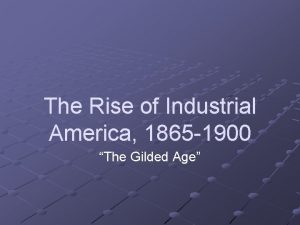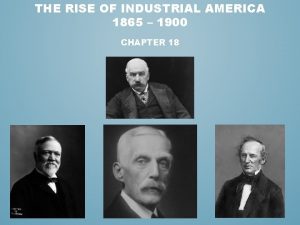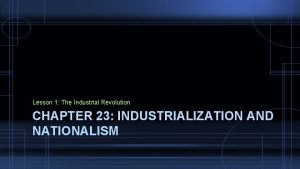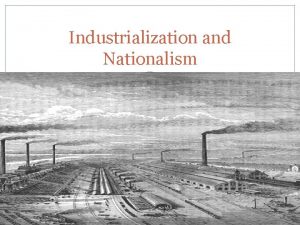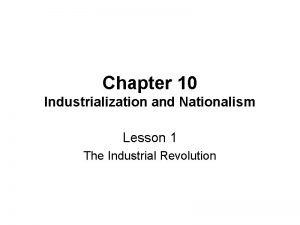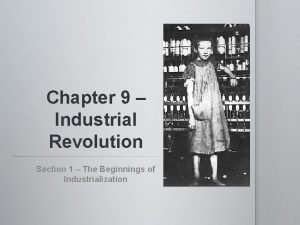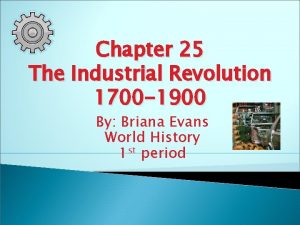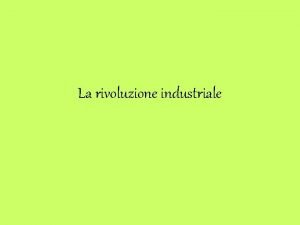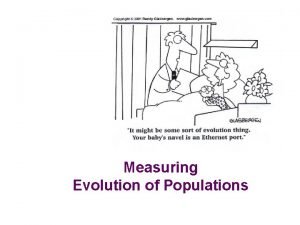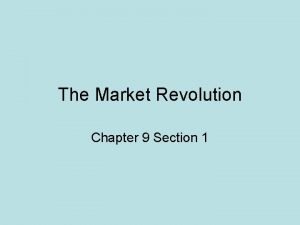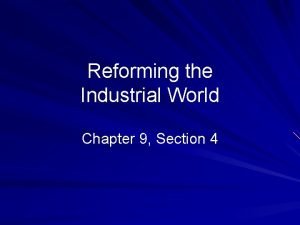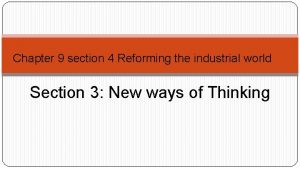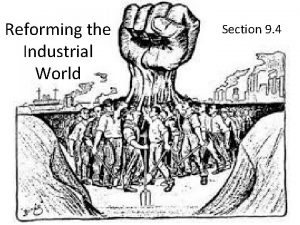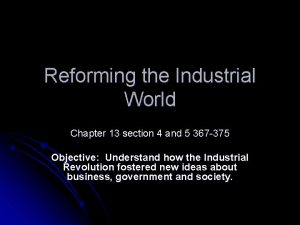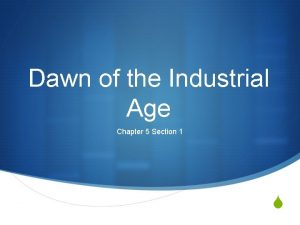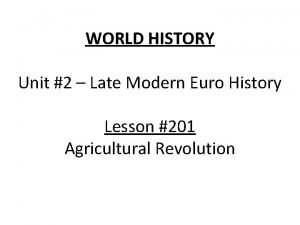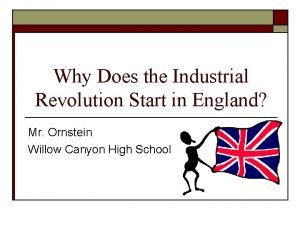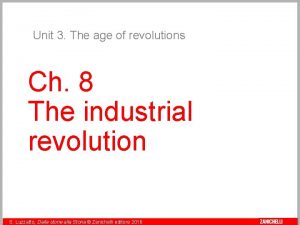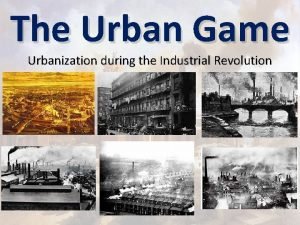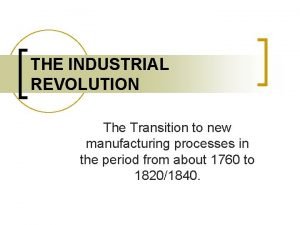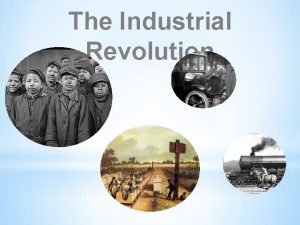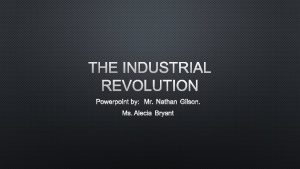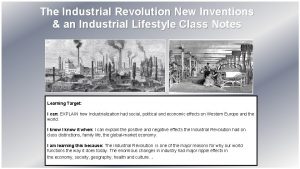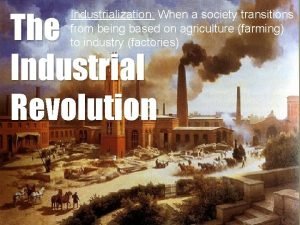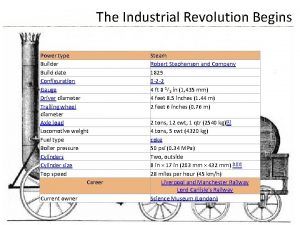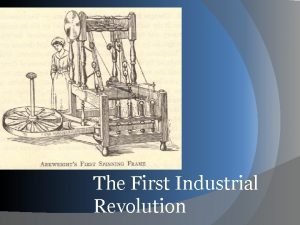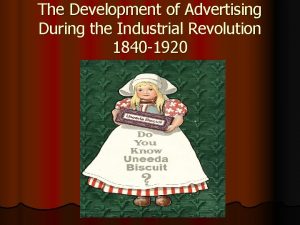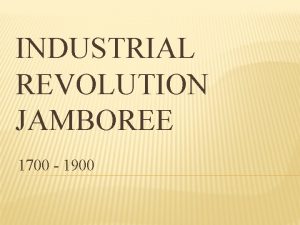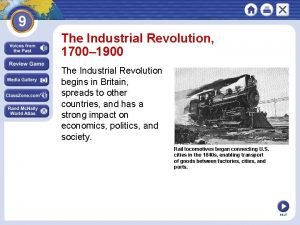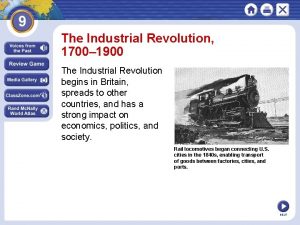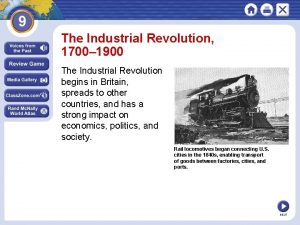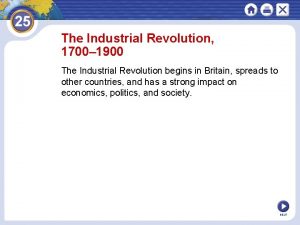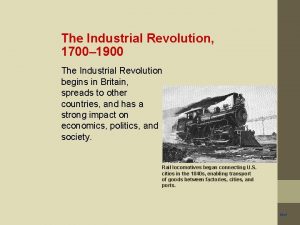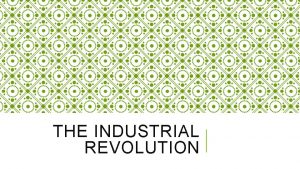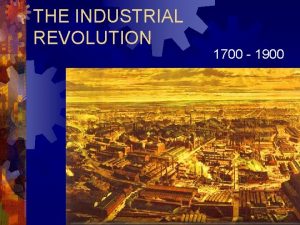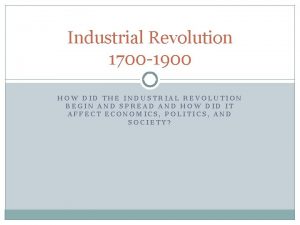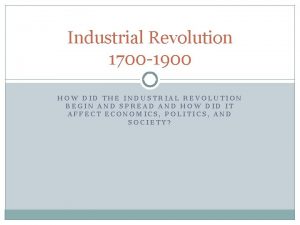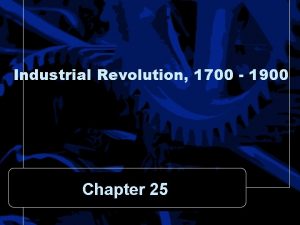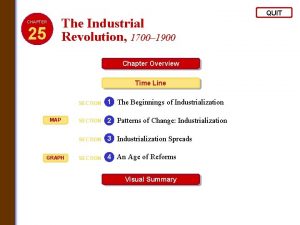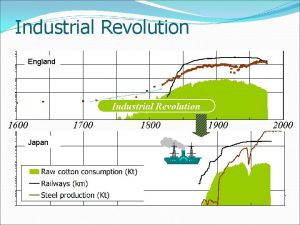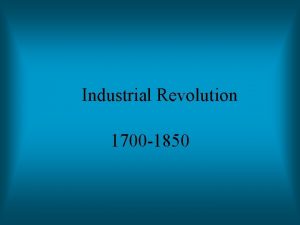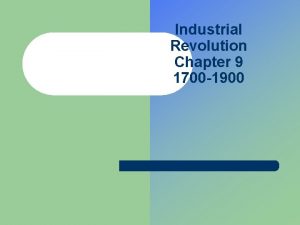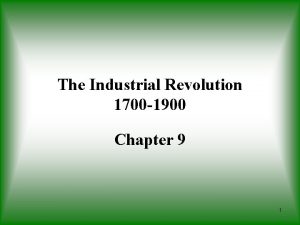CHAPTER 9 THE INDUSTRIAL REVOLUTION 1700 1900 SECTION























































- Slides: 55

CHAPTER 9 THE INDUSTRIAL REVOLUTION 1700 -1900

SECTION 1 The Beginnings of Industrialization

Main Idea The Industrial Revolution started in England soon spread to other countries.

Terms To Know Industrial Revolution Enclosure Crop Rotation Industrialization Factors of Production Factory Entrepreneur

The Industrial Revolution refers to the increase of machine goods that began in England in the middle 1700 s. This Revolution spread from England to Continental Europe and North America.

INDUSTRIAL REVOLUTION BEGINS IN BRITIAN Wealthy landowners dramatically improved farming methods. These new techniques amounted to an agricultural revolution.

Enclosures are a fenced in field created by landowners. This enclosure had two important results: 1. Landowners tried new agricultural methods. 2. Large landowners forced small farmers to become tenant farmers or to give up farming.

Jethro Tull was one of the first scientific farmers. He invented the seed drill in 1701. It allowed farmers to sow seeds in well-spaced rows.

“Rotating crops” The process of crop rotation proved to be one of the best developments by the scientific farmers. Crop rotation- is the practice of growing a series of different types of crops in the same area in sequential seasons. As food supplies increased and living conditions improved England’s population became larger.

“ Why the Industrial Revolution began in England” 1. 2. 3. 4. § • Four factors contributed to Industrialization in Britain included: Water and coal Iron ore to construct machines Rivers for island transportation Harbors for merchant ships Britain's highly developed banking system also contributed to the country’s industrialization. Land, labor, and capital were known as the factors of production.

INVENTIONS SPUR INDUSTRILIZATION “Changes in textile industry” Britain's textile industry clothed the world in wool, linen, and cotton. In 1733 a machinist named John Kay made a shuttle that sped back and fourth on wheels. Around 1764 James Hargreaves invented a spinning wheel named after his daughter, spinning Jenny. It allowed one spinner to work eight threads at a time. Wealthy textile merchants set up the machines in large buildings called factories.

New Inventions Spur Industry Textiles was 1 st major industry Spinning Jenny

INPROVEMENTS IN TRANSPORTATION “Watts Steam Engine” James Watt created a steam engine that worked faster while burning less fuel. In 1774 Watt joined with a business man named Matthew Boulton was an entrepreneur who paid Watt a salary and encouraged him to build engines.

“Water Transportation” Steam could also propel boats. Robert Fulton built a steamboat called the Clermont. The Clermont ferried passengers up and down New York’s Hudson River.

“Road transportation” John Mc. Adam equipped road beds with a layer of large stones for drainage. Private investors formed companies that built roads and then operated them for profit.

“Steam Engine Locomotives” In 1804 Richard Trevithick won a bet of several thousand dollars. He did this by hauling ten tons of iron over nearly ten miles of track in steam-driven locomotive. George Stephenson created the worlds first railroad line. It was to run from Yorkshire coal to the port of Stockton. The Liverpool-Manchester Railway opened officially in 1830.

“Railroads Revolutionize Life in Britain” 1. 2. 3. 4. The invention of the locomotive had four major effects: railroads spread industrial growth by giving manufactures a cheap way to transport materials. The railroad boom created hundreds of new jobs for railroad workers and miners. Railroads boosted England’s agricultural and fishing industries. Making travel easier.

Section 2 Industrialization

Main Idea The factory system changed the way people lived and worked, introducing a variety of problems.

INDUSTRILIZATION CHANGES LIFE By the 1800’s people began to earn higher wages on factories than on farms. Between 1800 and 1850 the number of European cities rose from 22 to 47. Most of Europe’s urban areas at least doubled in population. This period was one of the urbanization (city building and the movement of people to cities)

“Industrial Cities Rise” Britain’s capital, London, was the country’s most important city. It had a population of about 1 million people. Birmingham and Sheffield became ironsmelting cities. Liverpool, Manchester formed the center of Britain’s bustling cotton industry.

“Living Conditions” Because England’s cities grew rapidly, they had no development plans, or building codes. Most of the unpaved streets had no drains, and garbage collected on top of them. Workers lived in dark, dirty shelters, with whole families crowding into one bedroom. Elizabeth Gaskell was a British writer whose novels show sympathy for the working class.

“Working Conditions” The average worker spent 14 hours a day at the job, 6 days a week. Machines injured workers. A boiler might explode or a drive belt might catch an arm. The most dangerous conditions were all found in coal mines. Many children and women were employed in the mining industry because they were the cheapest source of labor.

CLASS TENSIONS GROW Middle Class was a social class made up of skilled workers, professionals, and business people.

“Middle Class” Landowners and aristocrats had occupied the top position in the British society. Some factory owners, merchants, and bankers grew wealthier than the landowners and aristocrats. The upper middle class consisted of government employees, doctors, lawyers, and managers of factories, mines, and shops. The lower middle class included factory overseers and such skilled workers as toolmakers, mechanical drafters, and printers

“The working class” The working class, saw little improvement in their living and working conditions. They watched their livelihoods disappear as machines replaced them.

POSITIVE EFFECTS OF THE INDUSTRIAL REVOLUTION It created jobs for workers, contributed to the wealth of the nation, fostered technological progress and invention greatly increased the production of goods and raised the standard living. Most important it provided the hope of improvement in peoples lives.

THE MILLS OF MANCHSTER Manchester’s business owners worked many hours and risked there own money. Children as young as 6 joined their parents in the factories. To keep the children awake, mill supervisors beat them.

THE MILLS OF MANCHSTER Manchester’s unique advantages made it a leading example of the new industrial city. It had available labor from the nearby countryside and an outlet to the sea at Liverpool. Manchester’s rapid, unplanned growth made it an unhealthy place for the poor people who lived and worked there.

Section 3 Industrialization Spreads

MAIN IDEA The industrialization that began in Great Britain spread to other parts of the world.

Terms to Know Stock Corporation

INDUSTIAL DEVELOPMENT IN THE UNITED STATES America had fast-flowing, rivers, rich deposits of coal and iron ore, and a supply of laborers made up farm workers and immigrants.

“Industrialization in the U. S. ” Young single women flocked from their rural homes to work as mill girls in factory towns. They received higher wages and more independence but were watched closely inside and outside the factory by their employers.

“Industrialization in the U. S. ” Eager to keep the secrets of industrialization to itself, Britain had forbidden engineers, mechanics, and toolmakers to leave the country. In 1789 Samuel Slater built a spinning machine from memory and a partial design.

“Later Expansion of U. S. Industry” During the last third of the 1800 s, the country had experienced a technological boom. These included a wealth of natural resources, oil, coal, and iron. Cities expanded rapidly due to their location near the railroads.

“The Rise of Corporation” To raise money entrepreneurs sold shares of stock, or certain rights of ownership. A corporation is a business owned by stockholders who share in its profits.

Industrialization in Belgiu, Belgium was the first country to follow the British in adapting new technology Belgium had rich deposits of iron ore and coal as well as fine waterways for transportation. Samuel Slater smuggled the design of a spinning machine to the United States. A carpenter named William Cockerill illegally made his way to Belgium in 1799. He carried secret plans for building spinning machinery.

Germany Industrializes Germany was politically divided in the early 1800’s. German manufacturers sent their children to England to learn industrial management. Germany built railroads that linked its growing manufacturing cities, such as Frankfurt.

“Expansion elsewhere in Europe” In Germany , industrialization during the early 1800 s proceeded by region rather than by country. In France industrial growth occurred after 1830. France avoided the great social and economic problems caused by industrialization. The accidents of geography held back others. In Austria-Hungary and Spain, transportation posed great obstacles.

THE IMPACT OF INDUSTRILIZATION “Rise of Global Inequality” Industrialized countries viewed poor countries as markets for their manufactured products. Other European countries began seizing colonies for their economic resources.

“Transformation in society” Revolutions in agriculture, production, and transportation changes the lives of many people. Industrialization gave Europe economic power Population, health, and wealth rose in industrialized countries. Middle class created great opportunities for education

Section 4 Reforming the Industrial World

Main Idea The Industrial Revolution led to economic, social, and political reforms.

THE PHILOSOPHERS OF INDUSTRIALIZATION Laissez faire refers to the economic policy of letting owners of industry and business set working conditions without interference.

“Laissez-faire Economics” Philosophers believed that if the government allowed free trade the economy would prosper. Adam Smith was a professor who defended the idea of a free economy. 1. 2. 3. Smith’s arguments rested on what he called the three natural laws of economics: law of self interest law of competition law of supply and demand

“The economics of Capitalism” Capitalism is an economic system in which the factors of production are privately owned and money is invested in business ventures to make a profit. Laissez-faire thinkers such as Smith opposed government efforts to help poor workers. They thought that creating minimum wage laws and better working conditions would upset the free market system, lower profits, and undermine the production of wealth in society.

THE RISE OF SOCIALISM “Utilitarianism” Jeremy Bentham introduced the philosophy of utilitarianism. Bentham believed that in general the individual should be free to purse his or her own advantage without interference from the state. John Stewart Mill believed it was wrong that workers should lead deprived lives that sometimes bordered on starvation. He wanted to help ordinary working people with policies that would lead to an equal division of profits.

“Utopian Ideas” A British factory owner named Robert Owen improved working conditions for his employees. He prohibited children under ten from working in the mills.

“Socialism” In socialism, the factors of production are owned by the public and operate for the welfare of all. Socialists argued that the government should plan the economy rather than depend on freemarket capitalism to do the job.

MARXISM: RADICAL SOCIALISM The writings of a German socialist, Karl Max introduced the world to a radical type of socialism called Marxism. While the wealthy controlled the means of producing goods, the poor performed backbreaking labor under terrible conditions. According to Marx the Industrial Revolution enriched the wealthy and impoverished the poor.

“The future according to Marx” Believed the capitalist system would eventually destroy itself. Factories would drive small artisans out of business. Marx described communism as a form of complete socialism in which the means of production would be owned by the people.

LABOR UNIONS AND REFORM LAWS “Unionization” A union spoke for all the workers in a particular trade. They bargained for better working conditions and higher pay. Strike was a refusal to work. Skilled workers led the way in forming unions. The combination Acts of 1799 and 1800 outlawed unions and strikes. 1875 British trade unions had won the right to strike and riot peacefully.

“Reform laws” New laws formed some of the worst abuses of industrialization. Parliament began investigating child labor and passed the Factory Act of 1833. The new law made it illegal to have children under 9 years old. Children 9 to 12 could not work more than 8 hours a day. Ages 13 to 17 could not work more than 12 hours.

THE REFORM MOVEMENT SPREADS William Wilberforce led the fight for the end of the slave trade and slavery in the British Empire. Parliament passed a bill to end the slave trade in the British West Indies in 1807. Women formed unions in the trades where they were dominated.
 The rise of industrial america 1865-1900
The rise of industrial america 1865-1900 The rise of industrial america 1865-1900
The rise of industrial america 1865-1900 Chapter 23 lesson 1 the industrial revolution
Chapter 23 lesson 1 the industrial revolution Lesson quiz 10-2 industrialization and nationalism answers
Lesson quiz 10-2 industrialization and nationalism answers Chapter 10 lesson 1 the industrial revolution
Chapter 10 lesson 1 the industrial revolution Power loom industrial revolution
Power loom industrial revolution Chapter 25 the industrial revolution
Chapter 25 the industrial revolution Defines the request mast policy for marines
Defines the request mast policy for marines Lexile level calculator
Lexile level calculator Joseph jardin fdny
Joseph jardin fdny Piano 1700
Piano 1700 1700 ce
1700 ce 3500 + 1700
3500 + 1700 Esapideak zerrenda
Esapideak zerrenda Rivoluzione agricola 1700
Rivoluzione agricola 1700 1700 luvun aatesuunta
1700 luvun aatesuunta Rotazione quadriennale rivoluzione industriale
Rotazione quadriennale rivoluzione industriale Puritan age in english literature
Puritan age in english literature To resize an embedded chart ____
To resize an embedded chart ____ 1 in 1700 us caucasian newborns have cystic fibrosis
1 in 1700 us caucasian newborns have cystic fibrosis Mobility express
Mobility express 1700 bce
1700 bce Chapter 6 section 1 the scientific revolution
Chapter 6 section 1 the scientific revolution Chapter 7 section 1 the french revolution begins
Chapter 7 section 1 the french revolution begins The french revolution begins chapter 23 section 1
The french revolution begins chapter 23 section 1 Chapter 6 section 2 the french revolution unfolds
Chapter 6 section 2 the french revolution unfolds Chapter 6 section 4 the american revolution
Chapter 6 section 4 the american revolution Red “liberty caps and tricolor”
Red “liberty caps and tricolor” Chapter 4 section 1 the revolution begins
Chapter 4 section 1 the revolution begins The market revolution chapter 9 section 1
The market revolution chapter 9 section 1 Chapter 6 section 4
Chapter 6 section 4 Chapter 7 section 2 revolution brings reform and terror
Chapter 7 section 2 revolution brings reform and terror Chapter 23 section 2 revolution brings reform and terror
Chapter 23 section 2 revolution brings reform and terror Russian revolution vs french revolution
Russian revolution vs french revolution Economic causes of french revolution
Economic causes of french revolution Definition of third agricultural revolution
Definition of third agricultural revolution Chapter 9 section 4 reforming the industrial world
Chapter 9 section 4 reforming the industrial world Chapter 25 section 4 reforming the industrial world
Chapter 25 section 4 reforming the industrial world Chapter 9 section 4 reforming the industrial world
Chapter 9 section 4 reforming the industrial world Chapter 9 section 4 reforming the industrial world
Chapter 9 section 4 reforming the industrial world Chapter 8 section 1 religion sparks reform
Chapter 8 section 1 religion sparks reform Chapter 19 section 1 dawn of the industrial age
Chapter 19 section 1 dawn of the industrial age How changed
How changed Why did the industrial revolution start in britain
Why did the industrial revolution start in britain Zanichelli
Zanichelli Urban game industrial revolution
Urban game industrial revolution Enclosure movement industrial revolution
Enclosure movement industrial revolution Long term impacts of the industrial revolution
Long term impacts of the industrial revolution The transition to new manufacturing processes
The transition to new manufacturing processes Industrial revolution quiz
Industrial revolution quiz Nathan gilson
Nathan gilson Positive effects of the industrial revolution
Positive effects of the industrial revolution The effects of the industrial revolution meme
The effects of the industrial revolution meme Multistory building divided into crowded apartments
Multistory building divided into crowded apartments Water frame significance
Water frame significance Industrial revolution advertising
Industrial revolution advertising
